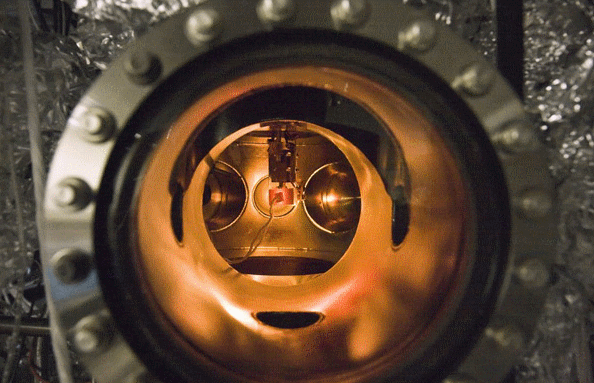 |
:: عضو ذهبي ::
تاريخ التسجيل: May 2009
الدولة: المغرب iguizzi06*hotmail.com // www.facebook.com/iguizzi.abdallah
المشاركات: 2,434
|
|
نشاط [ اكزي ]
قوة السمعة:148
|
|
 29-10-2010, 01:36 PM
المشاركة 4
29-10-2010, 01:36 PM
المشاركة 4
|
|

السلام عليكم
موضوع أخر
A new collector could double the efficiency of power plants

Traduction (français > anglais)
The new sensor is tested in vacuum at Stanford University
Add the advantages of solar photovoltaics - which converts light into electricity - to those of solar thermal energy, based on the exploitation of heat: such is the interest of a new type of sensor developed at Stanford University (California ) by the team of Nick Meloshe physicist. Named Pete (photon enhanced thermionic emission or "enhanced thermionic emission per photon), the new sensor is based, such as conventional photovoltaic cells on a semiconductor (gallium arsenide or nitride), but this time covered with a thin layer of cesium. This particular treatment can bring the optimal operating temperature beyond 200 ° C, high enough to recover through a conventional circuit (steam under pressure, with turbine and generator, for example). With standard sensors, in fact, more than half of solar energy is lost in heat emission in the material, without reaching a temperature sufficient to justify extraction. If the material and the process Pete meet expectations, the system efficiency (the proportion of energy converted into electricity) could reach 60%, triple the performance of a solar power today. Remains a yield increase to 30 or 40% would already be a major step forward, provided of course that the process - that Nick Meloshe present as relatively cheap - or industrialized.
بالفرنسية
Un nouveau capteur solaire pourrait doubler le rendement des centrales
Le nouveau capteur est testé sous vide à l'université de Stanford
Ajouter les atouts du solaire photovoltaïque – qui transforme la lumière en électricité – à ceux du solaire thermique, basé sur l’exploitation de la chaleur : tel est l’intérêt d’un nouveau type de capteur développé à l’Université de Stanford (Californie) par l’équipe du physicien Nick Melosh. Baptisé Pete (photon enhanced thermionic emission ou « émission thermionique améliorée par photon »), le capteur nouveau est basé, comme les capteurs photovoltaïques classiques, sur un semi-conducteur (nitrure ou arseniure de gallium), mais cette fois recouvert d’une mince couche de césium. Ce traitement particulier permet de porter la température optimale de fonctionnement au-delà de 200 °C, assez élevée pour la récupérer par le biais d’un circuit classique (vapeur sous-pression, avec turbine et alternateur, par exemple). Avec les capteurs standards, en effet, plus de la moitié de l’énergie solaire est perdue en émission de chaleur dans le matériau, sans toutefois atteindre une température suffisante pour en justifier l’extraction. Si le matériau et le procédé Pete répondent aux attentes, le rendement d’une installation (soit la proportion d’énergie convertie en électricité) pourrait atteindre 60 %, soit le triple du rendement d’une centrale photovoltaïque actuelle. Reste qu’un rendement porté à 30 ou 40 % serait déjà une avancée majeure, à condition bien sûr que le procédé – que Nick Melosh présente comme relativement économique – soit industrialisable.
|
Traduction (français > arabe)
ويمكن لهواة جمع جديد ضعف كفاءة محطات توليد الطاقة
يتم اختبار أجهزة الاستشعار الجديدة في الفراغ في جامعة ستانفورد
إضافة مزايا الطاقة الشمسية -- التي تحول الضوء إلى كهرباء -- لتلك الطاقة الشمسية الحرارية ، على أساس استغلال الحرارة : هذه هي المصلحة من نوع جديد من أجهزة الاستشعار المتقدمة في جامعة ستانفورد (كاليفورنيا ) من قبل فريق من الفيزيائي Meloshe نيك. المسمى بيت (الفوتون تعزيز انبعاث حراري أو "انبعاث حراري معزز لكل فوتون) ، واستشعار جديد يستند ، مثل الخلايا الضوئية التقليدية على أشباه الموصلات (أو نيتريد الغاليوم زرنيخيد) ، ولكن هذه المرة مغطاة رقيقة طبقة من السيزيوم. يمكن أن يحدث هذا العلاج خاصة جعل درجة حرارة التشغيل الأمثل تتجاوز 200 (على سبيل المثال تحت ضغط البخار ، مع التوربينات والمولدات ، و) جيم ، مرتفعة بما يكفي لاسترداد من خلال الدائرة التقليدية درجة. مع أجهزة استشعار قياسية ، في الواقع ، أكثر من فقدان نصف الطاقة الشمسية في الانبعاث الحراري في المادة ، دون التوصل إلى درجة حرارة كافية لتبرير الاستخراج. وإذا كانت المادة وعملية بيت تلبية التوقعات ، ويمكن أن كفاءة النظام (نسبة الطاقة تحويلها إلى كهرباء) تصل إلى 60 ٪ ، ثلاثة أضعاف أداء الطاقة الشمسية اليوم. لا تزال زيادة الغلة إلى 30 أو 40 ٪ ستكون بالفعل خطوة كبيرة إلى الأمام ، شريطة بالطبع أن هذه العملية -- التي نيك Meloshe بوصفها رخيصة نسبيا -- أو صناعيا
أعتمد على مترجم جوجل
|